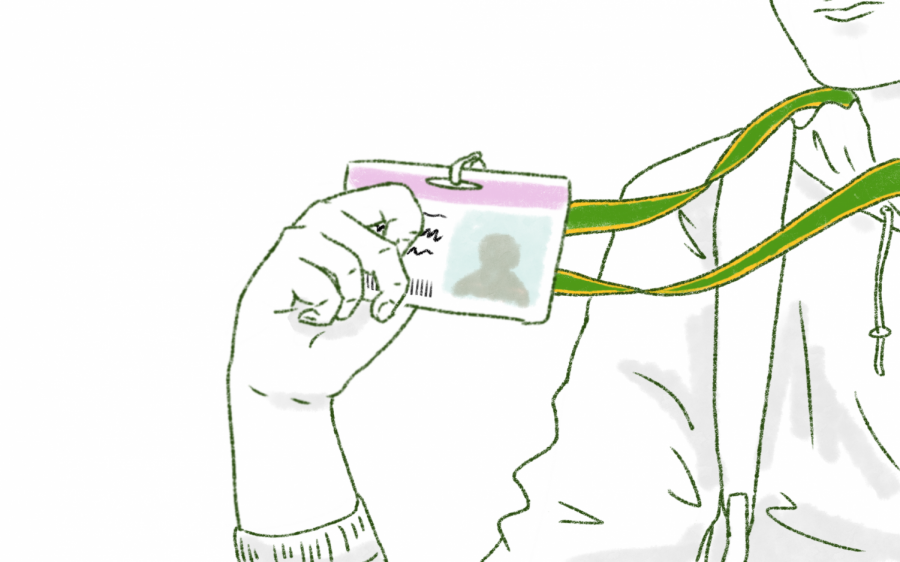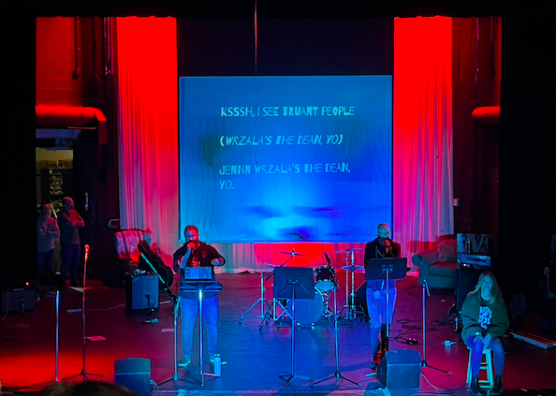Fremd ID system is broken
October 6, 2018
Fremd High School has many policies in place to ensure the security and safety of its students and faculty. The school resource officer, lockdown drills, door locks, security cameras, guest check-ins, and communication systems all effectively safeguard the people within the school from external hazards. Student IDs fall short of these other measures, and in some cases worsen school security.
The most obvious issue with the system in place is that it fails to thoroughly check IDs. With approximately 2600 students entering the school every day and only a few staff members to screen them, it is simply not possible to check every single student. Many students slip through the checkpoints without proper identification, hiding themselves in the great mass of people attempting to enter the school. Even among those with their IDs, so many give only an obscured flash of their cards, which is not sufficient to actually verify that the right people have access to the school. When closely examined, each ID can identify a Fremd student, but at the current volume and level of scrutiny, they only serve as blurry indications. It is not unheard of for Fremd students to “borrow” others’ IDs, clearly undermining the purpose of an ID—to identify a person. Though letting another student into the school seems to be harmless enough, it is just as easy to give an ID to an unauthorized individual. Without further resources or manpower, Fremd is not well equipped to deal with the possibility of a person’s identity not matching the piece of plastic in their hands.
But even if every single student were adequately checked for ID cards, what would happen to the actual security threats—malicious actors and hooligans wishing to penetrate the school? Would they be dissuaded by the ID-checking system, or would they simply ignore the school’s staff and enter anyway? As dedicated and hard-working as the ID-checkers may be, they are not security guards and only have a limited number of enforcement options available. These reliable adults may serve to identify potential threats early on, but IDs are not exactly conducive to this purpose if they are not consistently checked.
Compare that—the effect of IDs on security threats—with the effect of IDs on pupils. Students who repeatedly forget or misplace IDs are punished by deprivation of money and time spent replacing their IDs. They prove to be no threat to the school and don’t disrupt the learning environment, but they are forced to begin their day waiting in a line and paying a fine for doing essentially nothing. The people who the ID system is supposed to stop are not students of Fremd High School. They wish harm upon the school and the people in it. They will not willingly submit themselves to additional security screening. They do not care about paying a fine, waiting in line, getting detention, or being yelled at by an adult. Nevertheless, it seems that these are the methods which are used to enforce ID policies. This implementation is far less effective at stopping dangerous individuals than it is at punishing students, the very people who are supposed to benefit from the ID system.
Looking at these questionable practices, it is natural to wonder if the school administration has faith in the ID system. A cursory examination would indicate that it does. By making this ID ritual a part of every student’s morning, the school has shown a dedication to their strategies. But if they were confident that checking for student IDs actually improved the security of the school, why are these checks effectively stopped at 2:45? After school, there remain hundreds of students whose safety is still important. If Fremd believes that IDs were protecting them during the school day, why aren’t they protected during the afternoon? Though Fremd is by no means in grave danger because of this lack of consistency, it does indicate that the school probably doesn’t think that checking IDs is going to help security all that much.
Indeed, the school administration does seem to recognize that more concrete security measures would be necessary to maintain an ID system. An official school policy requires that, in addition to showing IDs at the entrances, students and staff must also display their IDs “throughout the school day, and during school related after school activities.” According to a July Fremd newsletter, this compulsory display is necessary because the “ability to easily identify students and staff improves school safety and security.” This policy is unenforced, to the point where students don’t know about it, and staff members don’t follow it. The primary issue with this nearly completely ignored regulation is that it misleads parents into thinking the school is safer than it actually is. Regardless of disuse and possible deception, it offers an interesting alternative to the system currently in place.
As it stands, IDs are mainly used by Fremd to verify that people entering the school are authorized. The written policy seems to indicate a more comprehensive approach, whereby continuous display of IDs would ensure security throughout the entire school day. If enacted properly, this could actually improve security by making sure that every person in the school belonged, identifying potential threats very early on.
However, the drawbacks to this policy make it practically infeasible. Since the goal would be to make all students wear their own IDs all the time, they would need to be thoroughly checked all the time—occupying valuable chunks of the day which could be used for instruction. Students also generally dislike wearing IDs, and this move would undoubtedly promote a lowering of morale or backlash.
This policy—which the school could very well decide to enforce at any point—exemplifies the inherent tradeoffs and downsides in every ID system. The ones that are the most secure make the school seem like a prison; the ones with the best security involve either costly automated electronics or large amounts of time; and the ones that try to cut corners aren’t secure. In light of these potential downfalls, it is pretty obvious why Fremd has chosen to maintain the status quo—facially, it seems pretty secure, and hasn’t failed yet.
This illusion of security is occurring with a backdrop of recent national developments which have galvanized a school culture increasingly centered around safety. Parents, more than ever, are demanding that schools be separated from the threats of the outside world. Fremd has had IDs for years, but their presence now serves as a pacifier to these concerns. The outward appearance of a security plan should not matter. Regardless of how IDs seem, we should not accept the school’s solution if it doesn’t work.
Still, it is very easy to be complacent. After all, every scenario where the school’s safety is threatened is a massive hypothetical, and the current ID policy is probably one of the last places where a solution would be found. Having an ineffective ID policy is therefore unlikely to jeopardize the safety of any student. However, students and parents should not take any excuses from the school. Fremd has a duty to maintain a safe learning environment. If a measure is designed but not adequately executed for this purpose, it should be dropped or improved. It should not be misguided and overstated. The best future path for Fremd’s student ID program may be an open question, but the administration cannot continue to explicitly and implicitly mislead students, parents, and the community on the safety of their school.



